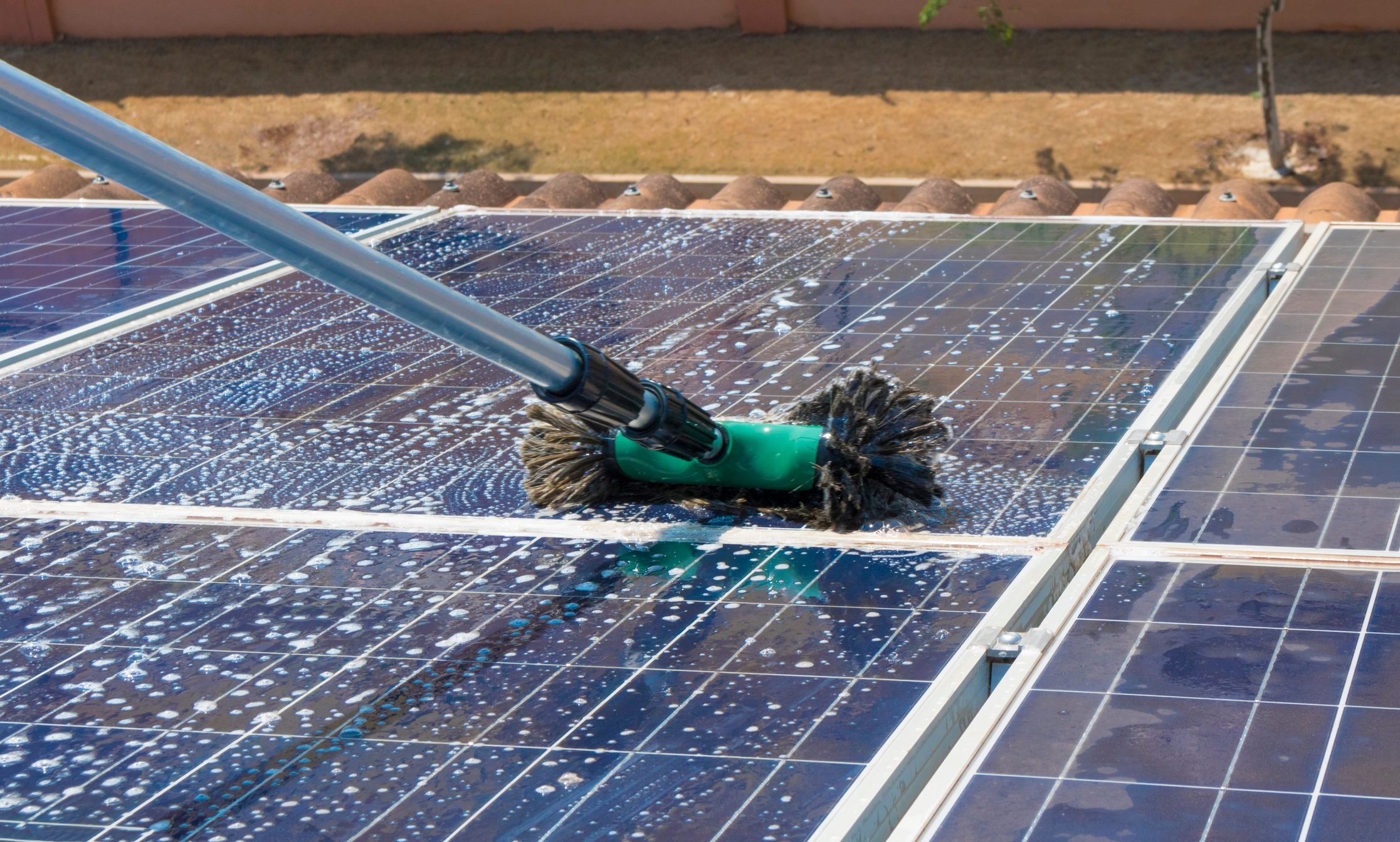Solar panels need to be clean to deliver optimal performance, and rain won't do the job. Find out how to keep your panels clean and in top condition.

What To Know About Cleaning Solar Panels

When my friends and I bought our off-grid property on California’s Central Coast, we found ourselves simultaneously blessed by a large, steep, south-facing hillside — an ideal location for solar panels — and bedeviled by the disastrously undersized system installed by the previous owners.
Five 200-watt panels supplied 16 humungous lead-acid batteries, which in turn fed the main panel through an external inverter. The system included a noisy 10-kilowatt (kW) diesel generator that kept the batteries charged when the panels weren’t doing the job.
Needless to say, the generator cycled on frequently. And after a few years of occupancy, we found the frequency steadily increasing. It took me that much time to discover why — we weren’t cleaning the panels.
We get little rain from April to November. During that time, dust settled on the panels and reduced their efficiency. Even the rain we did get didn’t clear the panels, and the residue sometimes compounded the problem.
As we upgrade the system, we’re making cleaning a monthly task. We’re luckier than some because the panels are at ground level and easy to access. People with roof-mounted panels have a potentially more dangerous job. Some roofs are really steep, requiring rubber-soled shoes and possibly a safety harness. Working from a ladder presents its own hazards.
If your solar panels are on your roof and you don’t feel confident climbing, consider booking professional cleaning and inspection. Solar maintenance pros operate in many communities. A cleaning typically costs $10 to $15 per panel, while an annual inspection for cracked glass, frayed wires and loose connections runs about $150.
On This Page
How Often Do Solar Panels Need to Be Cleaned?
Solar experts generally recommend every six months to a year, but much depends on local conditions. In areas with abundant rainfall, panel efficiency may not suffer if you wait longer between cleanings. But don’t wait too long. Rainwater contains impurities that leave a film on the glass. We don’t get snow, but people who do must remove that whenever it accumulates.
Panel placement is also a factor. Panels downwind of pollen-producing trees and vegetation must be cleaned more often than those upwind. It’s smart to inspect the panels every week or two and clean off any accumulated debris.
When Is the Best Time to Clean Solar Panels?
Cloudy days are best for cleaning. Solar panels get really hot in full sun, and the glass can crack if you douse them with cold water. If you have extended periods of sunny weather like we do in California, clean the panels in the early morning or late evening when they’re cool.
Seasonally, the best time for cleaning also depends on local conditions. In a region with heavy snowfall, a good cleaning in early spring removes debris deposited with the snow, while a mid-to-late fall cleaning clears contaminants that fly around in the summer air.
Smoke and haze from wildfires can also leave heavy deposits that should be cleaned whenever they occur.
How To Clean Solar Panels
If you’re cleaning roof-mounted solar panels, decide whether it’s safer to climb on the roof or work from a ladder. In either case, you’ll need a brush with a long pole.
Difficult as it may be to reach the middle of a single panel with your arm, it’s impossible to reach panels arranged side-by-side in an array. A brush on a telescoping pole allows efficient cleaning whether you’re on the roof or a ladder. Even better — although a slightly bigger investment — is a water-fed brush with attached squeegee.
Tools and materials to clean solar panels
- Garden hose;
- Pole soft-bristle brush;
- Glass cleaner or hard water stain remover;
- Garden sprayer;
- Window squeegee.
Step 1: Wet down the panel and brush away debris
- Use a garden hose to spray clear water over the entire surface of the panel. An expandable hose works best because it’s lightweight and easier to carry.
- Brush the panel with a soft-bristle pole brush to remove loose debris. Pay special attention the edges of the panel where dirt tends to accumulate, especially the bottom
- If you’re using a water-fed brush, turn on the water and brush while the water sprays.
Step 2: Spray the panel with glass cleaner
- Pour some concentrated glass cleaner into a garden sprayer and add water, per the directions. Spray the solution over the entire panel.
- Substitute hard water stain remover if you notice whitish deposits on the glass. They indicate calcium buildup that probably won’t come off with regular glass cleaner. Rain and snow are full of minerals that can leave such deposits.
- Pro tip: Don’t use soap of any kind. It will leave a film that partially blocks light.
Step 3: Scrub again
- Let the cleaner sit for a few minutes to break up dirt. Then scrub with your pole or water-fed brush, but don’t use any water.
- Spray and scrub repeatedly to remove stubborn hard water stains.
Step 4: Rinse with clean water
- Flood the panel with clean water from the garden hose. Use the pole brush to thoroughly clean off the glass cleaner or stain remover and all the dirt that comes with it.
- If you’re using a water-fed brush, turn on the water and brush and spray at the same time.
Step 5: Squeegee the panel dry
- Squeegee the panel in a horizontal or vertical direction, starting at the top and working down as if you were cleaning a windshield.
- Skip this step if you don’t have a squeegee long enough to reach. The panel will still be clean, but a few streaks may remain.




















